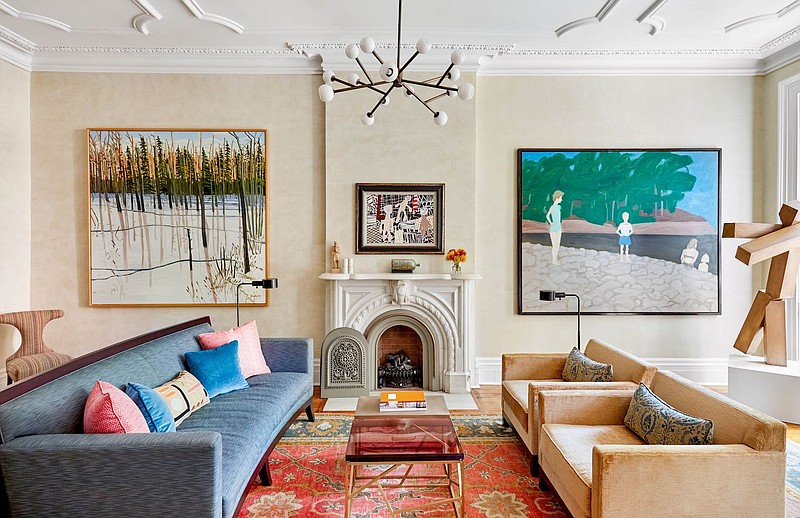"Start with a great rug." How many times have you heard that maxim from interior designers talking about how to decorate a room?
"OK, fine," I think to myself, "but then what?"
"Just pull color from the rug" is the rhetorical answer.
"Oh, easy for you to say," I think. If you're like me, you're left wondering which color, where, how much of it, solids or prints?
Now, those of you who already know the answers and think this is easy, kindly go smugly off to read some other section of the newspaper and leave the rest of us to muddle through.
Also, while I'm off the subject, allow me to address another peeve of mine: That mocking word "just" (as in just pull color) does not belong in any sentence that involves home decorating. I will leave it at that.
For me, this ability to "just pull a room together around a rug" doesn't "just happen," and yet, my favorite rooms are those that seem to effortlessly fall together around a fabulous area rug. When I encounter such a room, I try to visually deconstruct it to figure out what's working, but find no formula. I craved the secret.
So, recently, when I came across a photo of a living room inside an historic Manhattan townhouse in the West Village of New York, which had at its core a vividly patterned, room-unifying rug, rather than speculate, I called the interior designer behind the project.
"The easiest place to put a lot of color is on the floor," said New York designer Kathleen Walsh, owner of Kathleen Walsh Interiors. "Color on a floor has less impact than a bold pattern anywhere else in the room, but will still enrich and energize the space."
However, she added, "a patterned rug like this works best when everything else takes a step back. The minute you add something that competes, the eye gets confused."
Walsh's clients tend to fall into two groups, she told me: nonrug people and rug people. "For the nonrug group, looking at rugs is dizzying, while those in the other camp say, 'I can't decide on anything else until we have the rug figured out.'"
Either way, she adds, the choice of a rug, even if it's solid, should come early in the design process, after creating the furniture plan but before choosing furniture and pillows.

The reason designers often advise furnishing a room around a great area rug or a lead fabric is because these textiles have built-in curated color. This is the genius. Designers who really understand color and how colors work together have already created a palette that gives you a running start. However, to make sure you don't run off in the wrong direction and make one expensive mistake after another (as I have), here are some pro tips on how to (and how not to) decorate a room around a rug.
◼️ Give the rug the floor. If you are building a room around a colorful patterned rug, let the rug be the dominant voice in the space. "It's the main speaker," said Dallas interior designer and author Betty Lou Phillips. "Everything else needs to play a supporting role."
Don't upstage it, but do turn to it to find colors to pull out for large, upholstered pieces and accessories.
◼️ Don't amplify the dominant color. "When taking cues from an area rug or fabric, I like to pull the least expected hue," Phillips said. In the room I liked, for example, the rug's main background color was a deep pinkish orange. However, the rug also had teal blue in the border, which Walsh drew from for the upholstered sofa, and a sandy taupe, which she picked up in a pair of upholstered chairs. "The goal is for the furniture to sit on the rug and look separate from it," Walsh said, not blend into it. Echoes of the rug's background color can show up in smaller touches, such as pillows or other accessories.
◼️ Go solid on sofas. "Generally, I like for the sofa to be a solid so as not to distract from the speaker (the rug)," Phillips said. A contrasting welt, again picked up from a color in the area rug, can add energy.
◼️ Avoid an exact match. When pulling a color from the rug, don't try to hit it exactly, Walsh said. "Matched colors look boring. You want colors to be in the same family, but slightly off. That variation in hue makes color feel dynamic."
◼️ Keep other patterns at bay. If the area rug has a large-scale pattern, don't use another large-scale pattern on, say, the drapes. Choose a small-to-medium pattern for other fabrics, Walsh said. "But do use other patterns. Falling back on solids is a little lazy."
◼️ Color the whole room. To balance pattern and color on the floor, bring color up into the room onto the walls with art, wallpaper, or window treatments, and, perhaps, onto the ceiling with an interesting fixture. Then further distribute the selected accents colors throughout the room with pillows, throws and accessories.
"In a well-done room there's a reason for everything," Walsh said.
So, see, it doesn't "just" happen.
Join me next week to learn how to get the look of a high-end rug for one-tenth the price when you buy a good knock-off.
Marni Jameson is the author of six home and lifestyle books, including "What to Do With Everything You Own to Leave the Legacy You Want."
